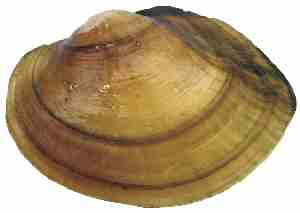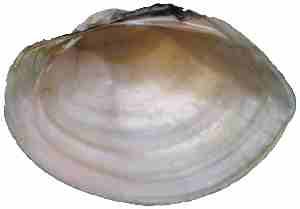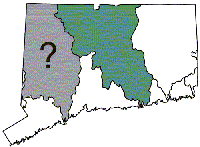Tidewater Mucket
Leptodea ochracea
Species of Special Concern
Key Features
Size: Up to three inches.
Shape: Ovate. Valves laterally inflated. Females usually more rounded toward the posterior ventral margin. Valves strong and uniformly thick.
Periostracum: Color yellowish or greenish-brown, sometimes with a bronze or reddish-yellow tint. Shell rays present, particularly in juveniles and light-colored adults.
Lateral Teeth: Present. Two on the left valve and one on the right valve.
Pseudocardinal Teeth: Present. Two on both the right valve and left valve. The teeth are thin and elongate, and are located well anterior of the beak [this feature is important to distinguish this species from the yellow lampmussel].
Nacre: Color pinkish or salmon-colored.
Often Confused With ... Yellow lampmussel, eastern lampmussel

External shell

Internal shell, right valve

Hinge teeth
 Habitat: The tidewater mucket is usually found in medium to large-sized rivers and coastal ponds, and inhabits a variety of substrates.
Habitat: The tidewater mucket is usually found in medium to large-sized rivers and coastal ponds, and inhabits a variety of substrates.
Range in Connecticut: Though rare, the tidewater mucket is found throughout the Connecticut River and its tributaries. It has not been found in the Housatonic River watershed since the 1800s.
Conservation: The tidewater mucket is listed as a species of special concern in Connecticut. Some recent evidence suggests that its range may be expanding, presumably due to river restoration and recovery of anadromous fish runs. Thorough surveys in the Connecticut River and its principal tributaries are needed to determine its population status and trends. It is listed as threatened in Maine and special concern in Massachusetts.
Freshwater Mussel Fact Sheets
Eastern Pearlshell
Dwarf Wedgemussel
Triangle Floater
Brook Floater
Creeper
Eastern Elliptio
Eastern Floater
Alewife Floater
Eastern Pondmussel
Tidewater Mucket
Yellow Lampmussel
Eastern Lampmussel
The Freshwater Mussels of Connecticut
Content last updated in March 2021.

